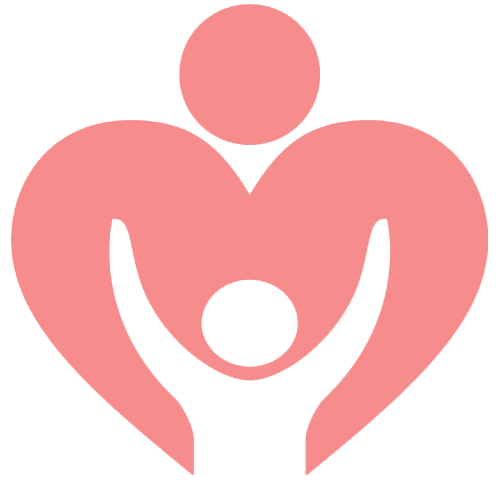The body of the child at the time of birth is still too far from a mature state. He is born small, helpless, and weak. A baby cannot survive without the help of adults, their care, and attention. It will take a very long time until he grows up and becomes a full-fledged adult organism.
Parents need to regularly replenish their knowledge so that they help their baby develop and grow properly. You need to know about the features of changes in growth parameters, the stages of speech development, and morphological and functional transformations within the body.
From 1 month to 1 year there is an impressive breakthrough in development. Passes a difficult way from a defenseless lump to a small person who can understand speech and interact with the world.
8 Month Baby Development
The child is actively moving and exploring the world around him at 8 months with great interest. This age is characterized by serious breakthroughs in the development of speech and cognitive functions, as well as a relative slowdown in growth. An increased interest in everything leads to sleep disturbances, schedule shifts, and the risk of overexcitation.
Functional and physical changes in the work of some organs and systems are noticeable. Consider the main points in the development of an 8-month-old baby.
- Sleep
- Weight
- Lenght
It's The Size of
a Strawberry
Based on length and size of a baby at 10 weeks pregnancy we can compare it to strawberry.
It does not feel like anything yet inside your belly, but structure is there and soon enough it will grow big.
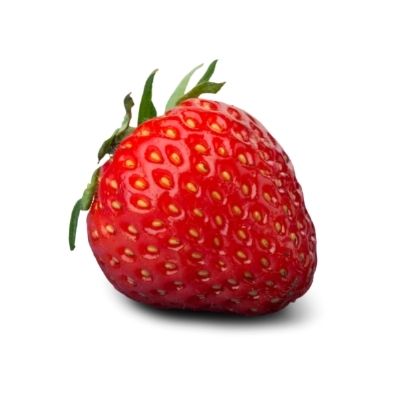
How Heavy is it?
0.15 oz ~ 4 gr
Bone structure and enlargement of head has made our baby at least to double in weight between week 9 and 10.
Slowly growing baby fetus is now at 4 grams or 0.15 ounces. Keep in mind that every baby weight during pregnancy is slightly different.
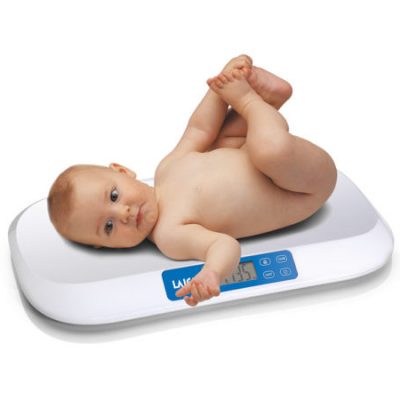
Your Baby is
3.2 CM or 1.25 Inch
It’s hard to measure baby inside your belly during such early development stage.
Overall night is just above one inch or 3 cm. The baby is not measured head to toe yet as it is in round position.

Baby parts development summary
Noticeable changes in digestion in an eight-month-old baby occur associated with the introduction of mixed nutrition. The enzymatic component and the nature of the functioning of the intestine are changing. There is a process of active teething. It significantly affects the child’s sleep, behavior, mood, and well-being.
The work of the brain and central nervous system is changing. New neural connections are emerging. The development of fine motor skills affects the activation of brain processes. The child analyzes the sensations received from the external environment and processes this information.
Muscles – Gradually, the arms, muscles of the thighs, abdomen, and torso become stronger. The child is getting ready to walk. The muscles of the legs become stronger. The kid can strain his muscles well and provide physical resistance when he doesn’t like something.
Brain – The number of synapses exceeds that available in adulthood. The width of the cerebral cortex increases and the volume of fibers increases. Nested groupings of neurons appear. These changes contribute to the improvement of information processing.
Excretory system – Kidneys mature morphologically and functionally. The number of glomeruli increases to 20. Homeostasis is maintained. The child begins to feel the desire to urinate and “signals” this from 8 months. There is an active formation of a conditioned reflex.
Digestive system – The child sat down and this changes the morphological features of the stomach and intestines. Regurgitation stops due to the formation of the locking section of the stomach. The intestines retain feces longer and the number of bowel movements is reduced. The stool becomes decorated.
Nervous system – The child is now in the stage of primary development of the sensory system. There is an active interaction of all senses. Visual, auditory, and tactile analyzers send signals to the brain and contribute to the formation of memory.
Skin and hair – The keratinized layer of the skin thickens slightly. Postpartum spots are gone. The amount of fine fluffy hair on the body is reduced. The bald spot disappears from the back of the head, caused by constant friction in the supine position.
Your Baby Growth at 8 month
The increase in body weight is completely due to the characteristics of nutrition, lifestyle, and even social factors in the development of the baby. Head circumference is slowly changing. This parameter for girls at 8 months will be 43.5 cm and for boys 44.8 cm. The circumference of the chest at this age practically does not change from the previous period. The circumference of the chest in girls is 43.5 cm. In boys, it is 44.5 cm.
8 Month Old Baby Milestones
Parents should become much easier and more interested in the child. Its progressive development is going up rapidly. Speech skills are being formed. The baby already understands that he can communicate through sound and physical actions. He associates his emotions with what is happening around him.
Motor activity stands out among successful developmental achievements. The child physically became much stronger than in the previous months of development. He is bold, inquisitive, and restless. He can no longer be kept in a prone position. The head and torso are spinning constantly and do not miss anything interesting.
Motor skills Children of 8 months already sit well and independently accept this position. They crawl by bending one of their legs under them. Many babies are even able to push themselves up against support and take their first cautious steps with support.
Improved coordination of movements. The musculoskeletal system is strengthened. The kid works on balancing and maintaining balance. He is interested in obstacles and hills that he is trying to climb.
Perception of the integrity of objects A single mechanism for the perception of form as an integrated whole emerges gradually. The integrity of perception becomes independent of changes in individual features. Form recognition invariance is formed.
Initial non-verbal categorization is possible by the end of 8 months. The kid groups object with varying but regular connected features and recognize them as the same type. Pyramid and sorter classes are well suited at this age.
Attention and behavior Elements of internal regulation and arbitrariness appear at 8 months. The child fixes his gaze on the predicted place of the appearance of the object based on individual experience and memory. This is observed during the game when parents hide the toy behind their back in their hand and then show it again.
An object that has disappeared from the field of vision does not disappear from consciousness. The kid perfectly understands that the toy is hidden behind the mother’s back.
Development of cognitive processes Cognitive processes are well developed during communication. This happens both at the sensory and motor levels. Efficiency to “functional” acquisitions in the cognitive-emotional sphere is noticeable at this stage.
The development of cognitive processes is largely based on visual perception. The kid gets acquainted with the outside world and accumulates experience. The child evaluates tactile senses by examining an object by touching it. He remembers its shape and color.
Development of speech A kid at this age pronounces syllables well. He constantly babbles and communicates with toys. The child perfectly understands what is being said to him. He is already able to respond with resistance to the word “no”.
The baby responds to its name. He knows who mom and dad are and turns his head in their direction. Some children at this age are already speaking their first conscious words. Most often it is “mom” or “dad”.
Subtle movements Fine motor skills are not fully developed. It will develop throughout childhood. The mobility and dexterity of the fingers directly affect the functioning of the brain.
The baby continues to master grasping movements at 8 months. They become stronger and more confident. The child feels everything around them and tries to grab even small objects. It synchronizes the work of the two hemispheres. Can easily transfer a toy from one hand to another, turning it over and examining it.
An 8-month-old child is characterized by noticeable shifts and successes in psycho-emotional, mental, and physical development. Infants of this age period actively use the connections of their actions with the results. They practice the volume of their voice and articulation skills.
There is an improvement in fine motor skills. Great progress has been made in communication and social behavior. Skills and abilities are developed in regime processes.
“A child of 8 months must sit and crawl well. Seek medical attention if this does not occur.”
8 Month Old Baby Health
Infants often present with symptoms of aerophagia. This is a functional problem associated with swallowing air when eating. It leads to frequent belching and probable pain in the epigastrium. This problem should go away with age. It is better to immediately consult with a gastroenterologist.
Often there are problems with the stool with the introduction of complementary foods. It becomes more shaped and dense. Constipation may appear with an insufficient drinking regimen. Regular intake of vitamin D3 continues. It is essential for proper calcium absorption and bone growth.
There are no mandatory vaccinations at 8 months. There should not be a strong tone of the muscles of the legs. This will significantly slow down the development of the baby and his first steps. Get a massage if needed.
Sleeping Schedules at 8 Month
Wake time increases greatly at 8 months. The child may not sleep for 3-4 hours in a row at this age. This drastically changes the sleep schedule and sometimes knocks parents off the regimen pace. Don’t miss the moment when the baby starts to refuse the third sleep.
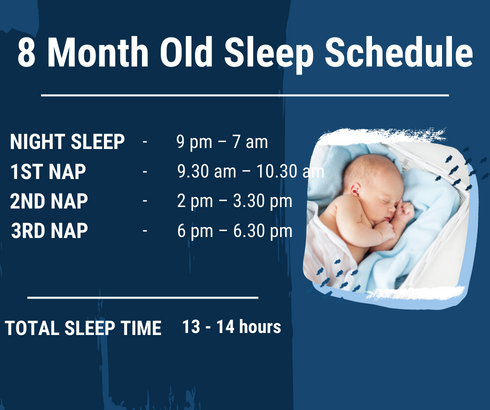
It is very important when forming a sleep schedule not to rush to remove the third nap. Let it happen by itself. The baby will show you his readiness for a 2-time sleep. He will strongly resist laying and acting up.
The sleep schedule should remain flexible. Your lifestyle is closely related to the regimen of the child and it can change. Do not try to put the baby to bed strictly by the clock and do not use the free regime. Watch for signs of fatigue and drowsiness: yawning, eye rubbing, moodiness. Invite your baby to take a short nap in the evening if he is tired.
8 Month Old Feeding
Mixed nutrition should be actively practiced at 8 months: breast milk or formula and complementary foods. The number of meals is at least 5. You can completely replace several breastfeeds if the baby eats complementary foods well.
The introduction of meat products at the age of 8 months is recommended: grated lean meat of chicken, turkey, and veal. This is extremely important because of the physiological tendency to iron deficiency anemia, which actively develops in children 8–9 months old. Use baby crackers, snacks, and dried fruits as snacks. Be sure to drink in the form of pure water and tea.
8 Month Old Baby Movements
An eight-month-old baby has already diversified his movements enough. He gets up with support where he can take his first hesitant steps. The child must necessarily sit well and move into this position independently from almost any state at this age.
Now there are coordination movements of the hands. The baby can clap his hands. He deftly manipulates objects, well controls the movements of both the right and left hands, giving preference to the leading one.
The activity of objective actions increases: grabs and holds a bottle with water or a mixture; holds a spoon and tries to use it for its intended purpose; bangs the toy on the surface. The child balances his movements while maintaining balance and practicing walking skills.
Safety Around Child
The strength and endurance of the child greatly increase at this age. The kid can overcome previously unconquered obstacles. He can climb onto a sofa or chair and independently rise from the floor. This requires increased security. The child may harm himself in the process of learning new skills.
The most relevant at 8 months is to provide the baby with a sufficiently large and safe space to move. This requires a revision of the arrangement of furniture in the house, and the installation of protective blocks on doors, windows, and cabinets. The kid can find sharp objects, get to a cup of hot coffee and drop it on himself.
Be careful about the availability of chemicals, electrical appliances, fragile glass, and sharp objects. Keep your baby away from medications.
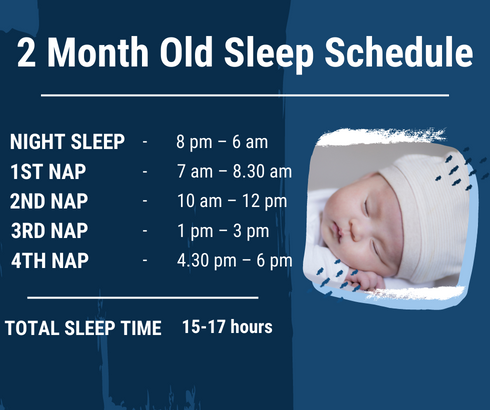
Stairs – Install safety barriers at the top and bottom of all stairs. Do not use sliding railings. They can pinch the child’s fingers or hands. Give preference to barriers with horizontal bars.
Doors, windows, lockers – Now the baby can reach a lot of handles. Install a lock on windows, balcony, and interior doors. Do not forget about the handles from the chests of drawers that are best removed.
Chemistry and toxic substances – Remove household chemicals, cosmetics, and acids to the topmost shelves. The curiosity of children knows no bounds. Any bright packaging, lids, or drawings can attract a baby. It is dangerous for his life and health.
Reservoirs and pools – There should be no unprotected water bodies and reservoirs with water on vacation or near the house. Children are always magically drawn to water. Consequences are inevitable without close attention.
Kitchen – Leave your child strapped into the safety seat while preparing meals. You can use the playpen. Do not wear your baby in a sling while cooking. Doing so may result in burns or other injuries.
Toys – Be especially careful when choosing toys for your child. They should not contain small parts, magnets, and sharp edges. Never leave your baby alone with developing games for motor skills.
What To Schedule Next
Schedule your next pediatrician visit and new doses of vaccines. The following boosters at 9 months are allowed: Hep B, Hib, and IPV. The Flu vaccine is often given at this age.
An additional examination by narrow specialists is appointed after a visit to the pediatrician. He carefully listens to the mother’s complaints and evaluates the urgency and need for a visit to a particular doctor. Complaints are most often related to digestion, lack of normal sleep, or the child’s anxiety.
It is recommended to schedule a course of massages and physiotherapy if the baby is not yet sitting and there is an increased tone of the lower extremities. Registration in the kindergarten is carried out according to the needs of each family. This visit is purely voluntary.
Parents Tips and Development Speed Up
Each new month of baby development brings adjustments to care, safety, and development. Focus on these age features. Replenish your stocks of useful information and learn how to properly communicate with your child. Draw knowledge only from proven, reliable, and reliable sources. Filter tips.
- Travel rules – The car must be in a lying position in a car seat. Take an adequate supply of water, food, a change of clothes, diapers, and hygiene products. Ask for seats with cradles on the plane in advance.
- Don’t abuse separation – A long absence of the mother can have a bad effect on the psyche of the child. He will become anxious and stressed. Better not to go beyond a few hours.
- Do not use walkers or other walking aids – The child’s stay in an upright position should be solely his initiative and physical readiness. Do not create an intentional load on the musculoskeletal system. The child will begin to walk when his muscles are strong enough.
The development of intelligence, memory, attention, fine motor skills and communication skills has its characteristics every month of life. The child needs your communication more than ever. This is the best tool for understanding the world. The child begins to recognize and understand speech. This expands the educational and learning abilities of the baby.
5 Development speed ups
- Reading – Start reading short stories with vivid illustrations. Show all heroes.
- Games – Expand play activities: arrange a shadow game, role-playing games, and construction sets.
- Sensory boxes – Fill boxes with kinetic sand and hide small toys in them.
- Sounding – Use memory cards. Name the objects, animals, and actions depicted in the pictures.
- Strengthening the back muscles – Spend every day in physical activity: exercising, crawling, lifting, turning over.
The success of your child’s development depends on the amount of attention paid to him by you. Attend special classes for the development of infants for up to 1 year if there is a shortage of personal time.
Do not miss this extremely important period in the life of the baby. Now the child is forming an attitude towards the world and the family. There is a strengthening of the foundation of the psyche and the development of intellect.
